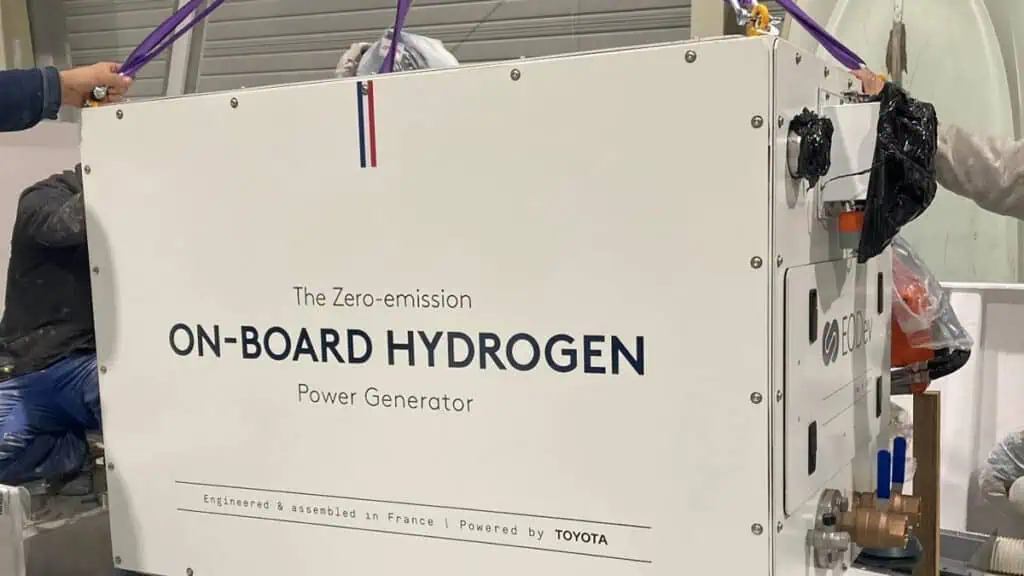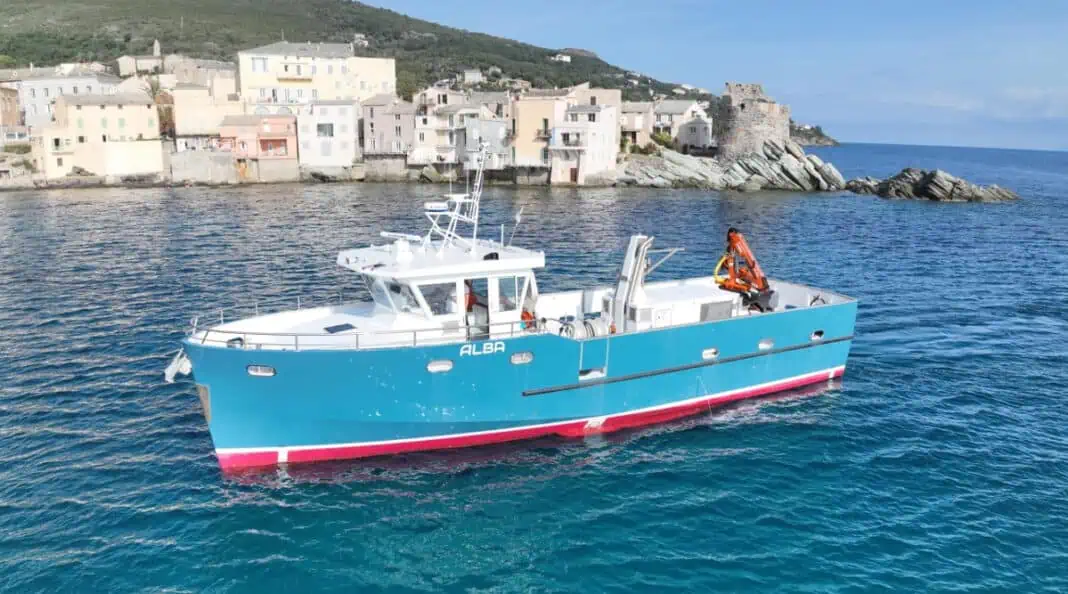On November 15, 2024,the LPMA : Maritime and Aquaculture Professional School of Bastia inaugurated “Alba”, France’s first hydrogen-electric powered fishing training vessel. MAURIC, one of Europe’s leading naval architecture and marine engineering companies, has designed the vessel and provided technical coordination for this innovative industrial project, demonstrating its capability to design Zero-Emission vessels through its expertise in naval architecture and complex systems integration onboard ships.
The LPMA of Bastia, laureate of the France AgriMer 2021 call for projects, was awarded a €4M budget for the development and construction of a Zero-Emission vessel through the France 2030 Recovery Plan. In April 2021, they published a Call for Applications for the design and construction of a 100% hydrogen-electric powered fishing training vessel.
MAURIC, designer of numerous Mediterranean fishing vessels, gathered a consortium with key players in the hydrogen sector and ecological transition, such as Alternative Energies, GATTO Shipyard and EODev, supplier of hydrogen fuel cell-based REXH2 Range Extenders, to respond to the LPMA’s tender.
In February 2022, our consortium and our project for a composite vessel under 20m equipped with two 70kW REXH2 Range Extenders were selected by the LPMA, allowing us to begin general design studies.
The design of a hydrogen power-propulsion system vessel requires the use of the Alternative Design methodology, incorporating multiple risk analyses (HAZID) to define the hydrogen system architecture, its integration into the vessel and consequently, particularly for a vessel under 20m, the general vessel architecture.
MAURIC, as both vessel designer and technical coordinator of the Consortium, coordinated all Alternative Design work, well beyond its traditional Naval Architect role. We led and organised HAZID sessions with SEIYA Consulting specialists. From the general design phase, the consortium engaged Mediterranean DIRM and Bureau Veritas classification society to involve them in the project and critical design choices.
Designing a Zero-Emission vessel means first designing an energy-efficient vessel. To achieve this, MAURIC’s high-quality hydrodynamic optimisations of the vessel’s hull plan, performed through CFD calculations on its 192-core computer, enabled the development of an extremely efficient hull plan. MAURIC also worked on optimising the composite structure, significantly reducing the vessel’s weight. The result? A maximum speed of 13 knots instead of the required 12 knots and an 11-hour autonomy at 10 knots, nearly 10% better than the LPMA’s required performance.
Alba has been specifically designed to include fishing training capabilities such as longline and seine techniques with MAURIC’s expertise. She can accommodate up to 12 students and 2 instructors (crew).
With an overall length of 19.95m, the maximum length allowed by the LPMA specifications, and a beam of 5.60m, Alba features a large deck area whose layout was defined in close consultation with the LPMA teaching staff. The vessel is fitted with removable winches and tackles for longline or seine fishing, with configuration changes possible within just a few hours. Space is reserved aft for a boat or fishing winch. Two hydraulic cranes complete the deck equipment.
The design ensures all areas of the vessel are accessible to multiple persons simultaneously, enabling fluid teaching, particularly in the wheelhouse for navigation and manoeuvring instruction, as well as in the Fuel Cell room where students and teachers can stand upright, uncommon in vessels of these dimensions.
Alba’s design perfectly illustrates MAURIC’s engineering culture, combining naval architecture expertise and mastery of complex systems integration. ” This project demonstrates our ability to technically coordinate major innovations, from CFD hull optimisation to the integration of state-of-the-art energy systems “, emphasises Guillaume Rocolle, Naval Architect and Project Manager at MAURIC .
Following validation of the general design, MAURIC completed all detailed engineering studies, particularly the interface studies between the H2 system (FCs, storage system and H2 network) and the vessel, specifically addressing safety aspects, fire prevention and fighting, ATEX zoning, in close collaboration with BV and consortium members.
In January 2024, the two 70kW EODEV REXH2 Range Extenders were integrated into the vessel, along with two 178kWh battery packs. The vessel features fully redundant power-propulsion architecture with two propulsion lines, two 200kW electric propulsion motors, two independent battery packs and two independent REXH2s powered by nine (9) bottles of hydrogen compressed at 350 bars, totalling over 75kg of hydrogen.

The vessel’s outfitting was completed in spring 2024, culminating in her launch in July 2024 at the CN GATTO shipyard in Martigues, France. Dockside and sea trials then began under MAURIC’s coordination for performance validation and regulatory compliance of the vessel and its equipment. Particularly, the H2 system commissioning and first dockside hydrogen bunkering for trials were significant project milestones that mobilised the entire consortium.
After several sea trials to validate all vessel operating modes (100% electric vs electro-hydrogen, navigation, manoeuvring, fishing operations), Alba safely reached her home port of Bastia, in Corsica on November 7th, 2024.
” This project represents a crucial milestone for MAURIC and our partners, but also for the entire French hydrogen sector, as Alba is not merely ‘H2-ready’. She is indeed the first French professional vessel operating exclusively on hydrogen and batteries. With this project, we demonstrate that hydrogen can be a viable technical solution for certain vessel profiles, that the technology is ready, and that France possesses the expertise to design and build professional H2 vessels “, states Fabrice GHOZLAN, Sales, and Business Development Director at MAURIC .
This achievement strengthens MAURIC’s position as a key player in maritime sector energy transition. Building on this experience, MAURIC now possesses unparalleled expertise in France for the design and construction of hydrogen vessels and supports its clients throughout all phases of hydrogen power-propulsion vessel projects, from design and construction supervision to delivery.
While hydrogen is one vector for maritime decarbonisation, MAURIC continues to invest in integrating decarbonisation solutions aboard vessels, such as wind propulsion, illustrated by the Neoliner Origin project for which MAURIC is the Naval Architect. For this project, we completed all general design studies and detailed design, particularly the integration of the SolidSail rig for the shipbuilder RMK Marine. Her launch is scheduled for the end of the first half of 2025. MAURIC is currently working on other vessel concepts with wind propulsion or wind-assisted propulsion for shipowners using different rigging technologies. The company continues to develop vessel designs using alternative fuels such as LNG/CNG, methanol, ammonia, or 100% electric propulsion.











